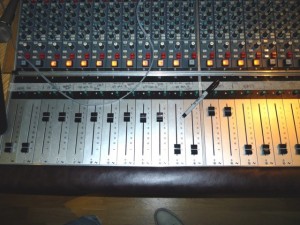by Glenn McGarry, PhD student, Mixed Reality Laboratory, University of Nottingham
‘Design Ethnography’ is a feature of the FAST project that is helping to drive technological developments within. These types of ethnographic studies seek to ‘get inside’ the work of a setting to gain first-hand knowledge of how work is accomplished through real-world, real-time organisation. Practically, this is done through direct observational fieldwork that is then analysed to inform the design of novel technical solutions.
Two such ethnographies of ‘traditional’ studio based music production activities (by University of Nottingham researchers) have recently been used by FAST project developers (from QMUL, Oxford University, and Birmingham University), to inform the design of a software demonstrator (scheduled for demo in December 2016). The demonstrator aims to show how labelling of audio in DAW software (Digital Audio Workstation) could be supported through intelligent instrument recognition. In this blog post, I give some background on how this concept came about via a series of FAST design workshops that reflected on scenarios derived from the studies .
 The first of the studies observed a rock band’s recording session. This involved a recording engineer capturing multi-track recordings of real-time band performances in a professionally equipped studio. The aim of the session was not to come away with a finished product, but for the engineer to take away multi-track audio that he could later edit and mix.
The first of the studies observed a rock band’s recording session. This involved a recording engineer capturing multi-track recordings of real-time band performances in a professionally equipped studio. The aim of the session was not to come away with a finished product, but for the engineer to take away multi-track audio that he could later edit and mix.
The second study observed another engineer creating a ‘pre-mix’. This involved the handling of multi-track audio taken away from a previous recording session, similar to the one in the first study. The engineer’s job was to create a mix that closely resembled the final product, for various stakeholders in the project to evaluate (musicians, record companies, investors etc.).
In keeping with the FAST project aims, the ethnographic analyses of the studies included observations on the creation and use of metadata. This potentially opens up new design prospects for metadata-driven tools to add value to music objects and support production. In our studies the metadata was in the form of labelling applied to the recording equipment and software, to signify the presence of audio (both analogue and digital).
In the recording study, the engineer labelled the recording console channels and the DAW software, to indicate a sound source’s signal path (e.g. guitar microphone) and groupings of audio by instrument. This helped organise the studio space and to aid location and interaction with recording equipment controls. He also reasoned that the digital labelling in the DAW was adequate as a substitute for notes for transferring session data to the mixing stage of the process.
In the pre-mix study, similar such labelling was transferred and used alongside the DAW session data, but not without issues. The engineer had to significantly reorganise the audio in the DAW before embarking on the new task in hand. For example, legacy audio objects, such as headphone sub-mixes used to aid musicians’ performances, were not needed and so removed. He also regrouped audio tracks by instrument, rearranging them according to his preference, and sought out tracks hidden by the recording engineer that were causing problems.
Issues of coordination between production stages were highlighted by these studies. In particular, the mix engineer’s unpicking of the recording engineer’s work before him and reworking of handed over resources was a significant overhead in work. Nevertheless, in a “what if” scenario where labelling was incomplete, absent, or stripped out by incompatible technologies, the overhead in work would have arguably been much greater.
The proposed demonstrator then aims to be the first step in generating and refining the utility of metadata in support of the production process. Automatic labelling through instrument recognition alone is perhaps not sufficient to completely transform production practice. Nonetheless it is a start in a direction that promises to at least find some efficiency gains and smooth the hand-over between production stages. The design prospects from the results of our ethnographic studies do not stop here of course and I will be doing more studies in the area of studio based production that will contribute to future FAST project impact.


